Real Life Examples of Machine Learning Across Key Industries
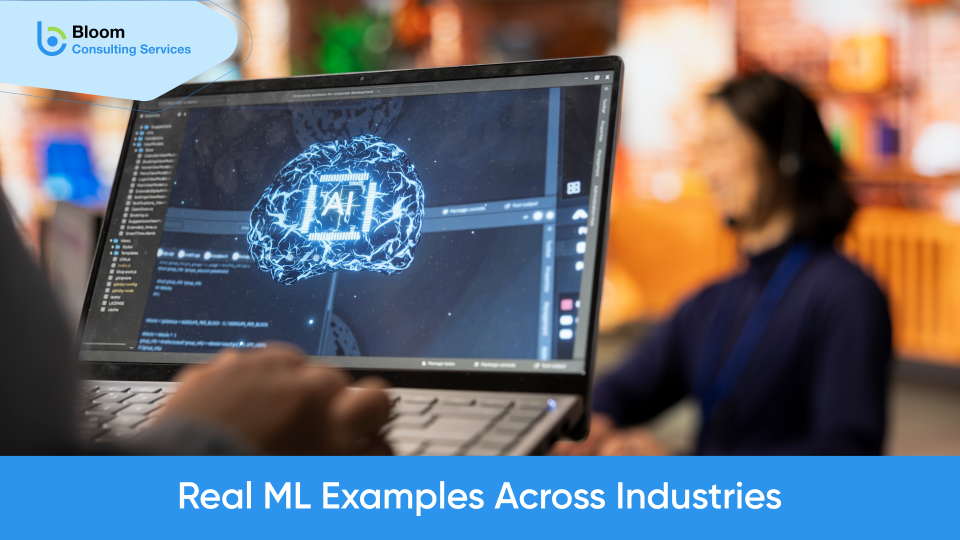
Machine Learning (ML) is not merely an overused term anymore. Rather, it is transforming all the businesses out there, altering the processes of decision-making, and, eventually, serving the customers. Widespread applications go from machine learning in health, finance, retail, energy to many others. The real-life examples of Azure Machine Learning Services is better explained through real-life examples, wherein Machine Learning is being used in various industries.
In this ever more data-driven world, ML is being increasingly deployed by companies to analyze large datasets, recognize patterns, and infer accurate predictions. From event fraud detection to demand forecasting in supply chains to personal healthcare, ML is solving these issues at the really big end of scale. These applications of Machine Learning onto the real world provide insight into how raw data can be converted into actionable information.
This blog explores how different industries are utilizing ML to innovate and grow. You will discover real life examples of Machine Learning on the job: from predictive maintenance in manufacturing to recommendation engines in retail. As we cover these applications, we will touch upon major industry trends and various use cases that highlight the flexibility and immediacy of ML in today’s business world. Let’s check out a few ways machine learning is altering industries.
Table of Contents
How Machine Learning Is Revolutionizing Healthcare
Machine Learning industries are among the most transformational industries touching on vital issues like disease diagnosis, drug developments, and patient care. Machine learning in healthcare is employed to sift through huge, complex, intricate datasets in order to extract hidden patterns that would otherwise go unnoticed, but which would lead to faster, accurate, and personalized care. Numerous real-life examples of Machine Learning are currently being used to improve the diagnosis, treatment, and management of diseases in hospitals, research centers, and biotech companies.
ML-based innovations are helping to move a mountain through imaging pattern detection, drug efficacy prediction, and patient treatment plan designs: so previously, going with an estimation might have been impossible or unimaginable simply due to time constraints. Basically, considered a give-and-take relationship, the impact of ML extends beyond efficiency and drives enhanced patient outcomes: the practice of medicine thereby becomes both more precise and proactive.
Let’s examine three major areas where real life examples of Machine Learning are providing significant opportunities for real value.
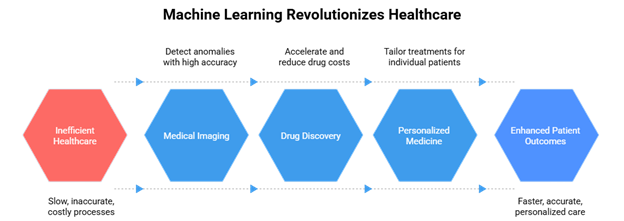
a) Medical Imaging and Diagnosis
Being one of the most familiar examples of Machine Learning implementations in healthcare, it finds its application in medical imaging. ML models trained on thousands of X-rays, MRIs, and CT scans identify instances of anomalies such as tumors, fractures, or infections with near-human accuracy. These models assist radiologists in flagging suspicious areas, thereby reducing the chances of human error and giving them more time for diagnosis.
With the help of such ML tools integrated into the radiology workflow, healthcare practitioners can track diseases much earlier and arrive at better decisions. This is especially important in cases of cancers in which early detection can largely improve patient survival rates.
b) Drug Discovery and Development
Developing medications requires a very long time and lots of money, but real power machine learning examples are changing this notion. ML algorithms tackle chemical and biological data to find out how a chemical compound might affect a living body. This approach allows scientists to find prospective drugs much more efficiently and select those with the greatest probability of success.
Machine Learning is applied to patient data during clinical trials to predict response to treatment and assist in trial design. These innovations cut down on the time for drug development and make it cheaper while bringing efficacious treatment to market faster
c) Personalized Medicine
Personalized medicine uses ML algorithms to define treatments for individual patients based on genetics, medical history, and lifestyle. These examples of Machine Learning in the real world analyze large datasets to recommend therapies with the highest probability of being effective for each subject. This helps to lessen the trial-and-error process in treatment, ameliorate patient outcomes, and reduce the chances of side effects.
In the realm of healthcare, machine-learning personalization is being employed to shift the emphasis on the predictive, data-driven, and patient, rather than one-size-fits-all.
Stay ahead with AI—start your journey today
How Machine Learning Is Powering Smart Manufacturing
Being a key part of production, Machine Learning is bringing ever faster changes in manufacturing. Being a huge data ecosystem, factories are a perfect-moving case of ML to optimize processes, minimize downtime, and guarantee quality. Across the various production floors in manufacturing plants across the globe, Machine Learning real-life examples are creating efficiencies, cutting costs, and ushering in operations-based predictions.
Machine Learning allows manufacturers to go from reactive to proactive decisions. These systems examine sensor data, identify anomalies, and forecast events to supply more dependable and agile production environments.
Let us look at the top three Machine Learning real-life examples pioneering the manufacturing industry.
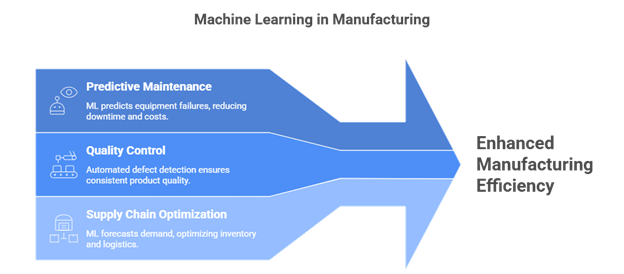
a) Predictive maintenance
In the field of manufacturing, predictive maintenance is one of the brightest examples of Machine Learning. ML models keep an eye on sensor data from machinery and tell if there is something wrong, predicting the time when the machinery will be in some stage of failure. Knowing about it in advance, maintenance teams repair the issue before any actual breakdowns occur, wasting less time in a halt for repair and saving monetary costs of production delays.
By minimizing unexpected equipment failure, using Machine Learning for predictive maintenance Machine Learning can delay equipment replacement, reduce downtime, and optimize maintenance schedules, thus helping save money and increase productivity at the factory floor.
b) Quality Control
ML is making much of the difference in quality control by way of automated defect detection in real time. These real-life examples of ML employ computer vision for examining products on an assembly line, invalidating any product that doesn’t pass the quality standards. Faster than human inspection and much more accurate, too.
This automation guarantees consistent product quality, allowing for waste reduction and conformation to regulatory requirements. With ML, defect detection happens either on time, or even after the defect appears, with the root of the problem being determined quickly so that continuous process enhancement can take place.
c) Supply Chain Optimization
ML aids manufacturers in managing their supply chains by forecasting demand, inventory requirements, and logistics. Real life examples of Machine Learning examine historical and real-time data to forecast instances were stock shortages, delays in delivery, or changes in customer demand that could occur.
Therefore, companies can alter production schedules, structure inventory intelligently, and react to the changes in the market in real-time. Supply chain optimization, based on Machine Learning, adds flexibility to service costs, timely solution for delivery, and makes the whole scenario more resilient and customer oriented.
How Machine Learning Is Reshaping Finance
The financial services sector is all about data in decision-making, and machine learning (ML) is changing the way we use this data. From fraud detection and credit scoring to investment strategy, real life examples of Machine Learning have made financial operations quicker, safer, and smarter. Banks, insurers, and fintechs utilize ML in staying competitive and reliably servicing their clients.
Processing immense volumes of financial data with ML models reveals hidden risks and opportunities. Such insights help institutions improve accuracy, curtail losses, and enhance customer experience. We will now explore key examples of Machine Learning in financial services.
a) Fraud Detection
Fraud detection in a real-time setting is perhaps the most powerful example of Machine Learning in finance. ML models analyze abnormal transaction patterns and suspicious activities that could imply fraud to offer immediate reactionary actions and loss prevention.
In contrast with a rules-based approach, ML is designed to learn and adapt to new ways of committing fraud based on recent examples. Therefore, banks protect customer accounts better, while at the same time they lessen false alarms and ensure seamless transaction flows.
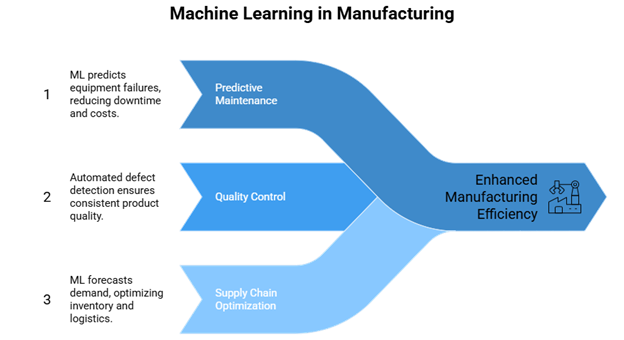
b) Credit-Scoring and Underwriting
ML makes credit scoring more efficient by analyzing alternative data along with financial history, not just the latter. Payment behavior and social signals are just some examples of alternative data that Machine Learning can use to assist lenders in assessing risk on a more accurate basis to arrive at faster and fairer lending decisions.
In underwriting, ML models estimate the likelihood of repayment so that banks can craft terms that best suit their needs and reduce defaults. This facilitates easier loan approval and wider access to credit among underbanked customers.
c) Algorithmic Trading
Machine Learning enables Algorithmic Trading within investment management by analyzing the market for trades and trade possibilities. These real-life examples of Machine Learning help financial institutions respond to market changes in real-time and execute buying and selling at optimal prices.
ML models will look at news, social-media trends, and past-price-action to forecast market movements. This data-centric approach minimizes human errors to maximize investment returns, thereby presenting the firm with an edge in fast-moving markets.
How Machine Learning Enhances Shopping Experiences
Retail and e-commerce are fast-moving industries in which customer satisfaction and operational efficiency matter the most. Depending on data-driven technologies, examples of real-life Machine Learning are now being used at the very core of these businesses. It is from suggestions personalized to inventory controls that ML changes the way a person shops.
ML helps retailers understand customer preferences, anticipate new trends, and optimize marketing, sales, and order fulfillment. With the booming growth in digital shopping, firms using even a few examples of Real-Life Machine Learning will be in a far better position to serve their customers, convert sales, and earn their brand loyalty.
Let’s find the key applications of ML in retail and e-commerce.
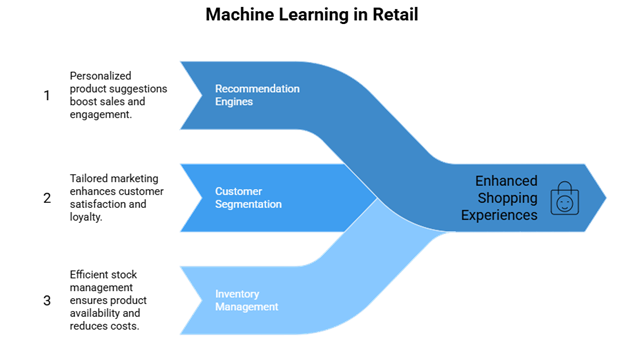
a) Recommendation Engines
One of those prime real-world examples of Machine Learning present in e-commerce is product recommendation. ML essentially reaches out to persons’ behavior in buying and browsing to check what products a person is likely to purchase. This sort of personalization increases engagement and drives sales.
Recommendation engines now populate big retail sites, contributing from 20 to 35% of the sales. By recommending products or items, Machine Learning creates a customized shopping experience for each user.
b) Customer Segmentation
Retailers can segment customers through Machine Learning by demographics, purchase history, and behavior. These real-life examples of Machine Learning help businesses maximize marketing efforts; by targeting specific marketing techniques, it becomes more individualized and thus increases conversion.
Segmentation helps brands understand customer needs and preferences so as to design products or services that appeal to different audience segments. This exercise boosts customer satisfaction and, hence, loyalty.
c) Combining Inventory with Demand Forecasting
Managing stock effectively is the lifeblood of any retail business. It is done by predicting the demand through sales data and trends, seasonality, and external factors. These Machine Learning examples allow retailers to circumvent excessive buying or severe lack of stocking of popular items.
If demand forecasting is done accurately, inventory can be optimized, costs reduced, and supply-chain efficiency increased. This manufacturing, apart from ensuring product availability, also ensures experience.
Turn AI trends into business success
How Machine Learning Optimizes Movement and Delivery
Transportation and logistics are complex businesses that revolve around timing, efficiency, and costs. Increasingly, companies in this space are using data-driven tools to gain competitive advantage. Examples of Machine Learning in the real world reveal that delivery times can go up, fuel costs can go down, and route planning gets better.
From managing vehicle fleets to forecasting shipment demand, ML actually makes logistics smarter, faster, and more dependable. These innovations, in turn, help companies quickly respond to disruptions, customer needs, and market fluctuations. So, let us go into how some real-life examples of Machine Learning are changing the face of logistics operations.
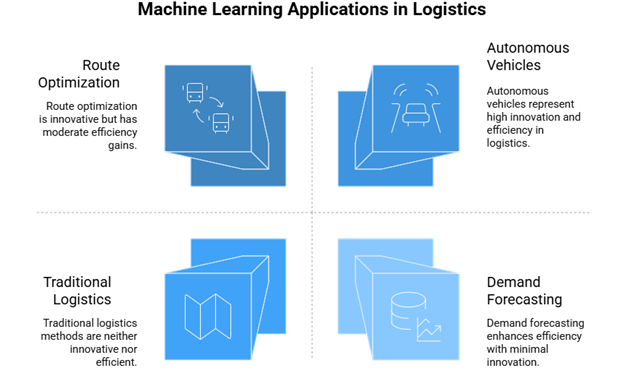
a) Route Optimization
ML is involved in route optimization since delivery route optimization is meant to be one of the main applications of Machine Learning. These real-life examples of Machine Learning take into consideration data on traffic, weather, and delivery schedules to optimize route planning. This then cuts down on fuel usage, travel time, and operational costs.
Route optimization, then, helps with faster delivery and better customer satisfaction by logistics companies. It also aids in achieving environmental objectives as it helps reduce emissions of vehicles due to efficient transport planning.
b) Autonomous Vehicles
Self-driving cars are now among the most futuristic applications of Machine Learning in transportation. ML algorithms are used so these vehicles can perceive their environment, make real-time decisions, and navigate safely.
Still rather new, autonomous trucks and drones are being tested for shipping goods. These technologies intend to alleviate truck driver shortages, reduce labor costs, and function 24/7, increasing logistics efficiency and scalability.
c) Demand Forecasting
ML forecasts shipment volumes, delivery requests, and warehouse needs for logistics companies. These scenarios are instances of Machine Learning used to predict demand accurately using historical data, as well as real-time inputs.
Good forecasting can better equip a business to maintain inventory and staff while matching delivery capacity. It allows for on-time delivery, efficient use of resources, and cost reductions across the supply chain.
How Machine Learning Is Powering Smarter Energy Solutions
The shifting of the energy industry into a transformation correctly is aimed at efficiency, sustainability, and charging renewable energies. Companies, therefore, are adopting the advanced technologies, with real-world examples of Machine Learning playing a critical role. From forecasting energy demand to grid optimization, ML helps collectors in rendering power systems more reliable and greener.
ML models gather enormous energy data, analyze them in real time, and help utilities manage supply and demand, reduce wastage, and perform better on grid performance. These intelligent systems are erecting the path for a more resilient and sustainable energy future.
Let’s see how real-world examples of Machine Learning shape energy management and production.
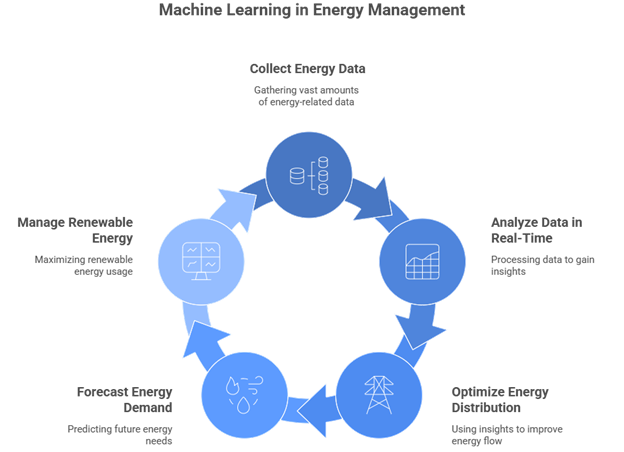
a) Smart Grids
In energy, smart grid optimization presents one of the most powerful real life examples of Machine Learning. Machine Learning delivers utilities energy load balancing, consumption forecasting, and fast responses to outage or surge in demand.
Machine learning helps in optimizing smart grids and in the efficient distribution of energy, thereby reducing blackouts and energy losses, as well as making quicker decisions regarding grid operations.
b) Energy Consumption Forecasting
Energy companies use predictive models based on historical energy usage, weather-related parameters, and customer behavior. These are some Machine Learning real-life examples that allow utilities to respond more accurately to energy generation and distribution requirements.
Assuring the right level of production helps prevent costs caused either by the accommodation of surplus energy or by the accommodation of shortage energy, while also contributing to environmental implications. Customers benefit from managing their own energy use through the suggestions given on consumption profiles.
c) Renewable Energy Optimization
Renewable sources include solar, wind, etc., which by nature are widely variable. ML models predict energy output by analyzing weather data and equipment performance. These are real life examples of Machine Learning which help in maximizing the utilization of renewable energy while minimizing downtime.
In generating energy, ML lends its supporting hand for transforming to cleaner energizing mechanisms, for example, ensuring renewables maintain harmony with the grid to augment sustainability and to depend more on fossil fuels.
How Machine Learning Is Transforming Modern Farming
While agriculture basically follows tradition, there’s an increasing connotation for the term high-tech. Real life examples of ML applications in agriculture show how crop management, livestock monitoring, and yield prediction have become data-intensive. Farmers are using machine learning to increase productivity, conserve scarce resources, and face climatic challenges.
ML profusely uses integrations of soil data, weather data, and crop data to best-in farm decisions. Agriculture with precision means working with machine learning to guard the use of water, fertilizers, and labor for better efficiency and sustainability.
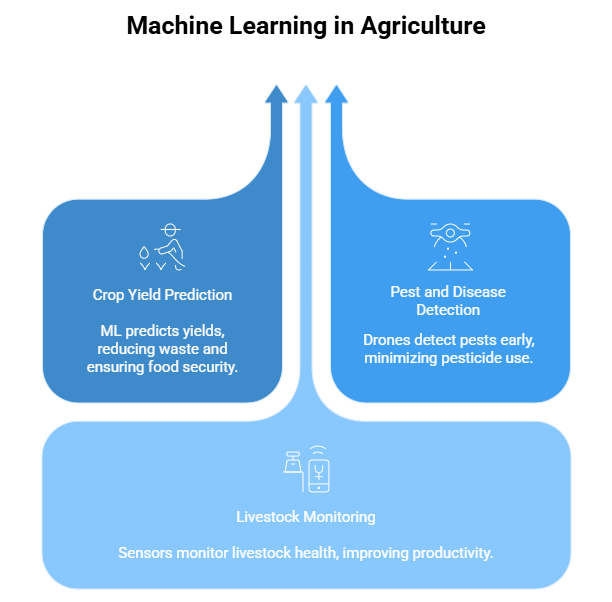
a) Crop Yield Prediction
Using crop historical data, weather data, and satellite imagery, machine learning models are trained to predict crop harvesting yields. These projects showcase real life examples of Machine Learning that enable farmers to plan, manage risks, and meet market demands.
Accurate prediction leads to reduced waste and loss of incomes, and hence food security. It becomes even more important in an area affected by climatic variability.
b) Pest and disease detection
Drones powered by ML and sensors monitor the green fields for the first signs of pests or diseases. Real life examples of Machine Learning allow intervening just-in-time to arrest crop loss and lessen pesticide use.
Early detection really saves on cost and environment. It also ensures quality crops and provides better prices for the farmers.
c) Livestock Monitoring
ML processes data from sensors on livestock with the objective of monitoring health, movement, and productivity. Machine Learning-Live examples help farmers in early detection of illness and improvement in feeding schedule.
Hence, animals will remain healthier, give a better yield (milk, meat, eggs), and make the farm a bit more efficient. Smart agriculture is fast emerging as one industry of Machine Learning pushing rural innovation.
How Machine Learning Enhances Learning and Teaching
Education is changing with the growth of digital tools, and Machine Learning real life examples make learning more personal and effective. ML methods enhance student achievement while also aiding teachers, from adaptive learning systems to automated grading.
ML contributes toward the creation of tailor-made learning experiences by analyzing student outcomes and student engagement. It is able to recognize students at risk early and make resources available to help them succeed.

a) Adaptive Learning Platforms
ML powers platforms that adjust content based on student needs. This is a Machine Learning real life example that allows students to master content at their own pace and concentrate on areas that require improvement.
The individualized learning approach will greatly improve retention and engagement, which makes learning easier and more effective for all kinds of learners.
b) Automated Grading and Feedback
These systems are able to grade ML assignments, quizzes, and even essays. This Time Saving ML real-life example takes away time-consuming tasks from teachers, while also providing immediate feedback to students.
Students learn better when the feedback is faster, and teachers, meanwhile, can then concentrate on giving personalized instruction.
c) Learning Analytics
Machine learning inspects learning data to unearth trends and forecast student success. Such real-time Machine Learning instances enable the institution to fine-tune an existing curriculum and better support student needs.
Improving the quality of education and its outcomes are preferably done through data-informed decisions. Today, such tools have become integral to industries using machine learning to build better services.
Marketing and Advertising Industry
Marketing today is highly data-driven, and real-life examples of Machine Learning drive personalization and campaigns, customer insights, and ad optimization for advertising. With ML, brands strive to hit the target audience with the right message at the right time.
With this, marketers can analyze behavioral information, segment audiences, and predict actions. This results in better ROI and optimized engagement strategies.
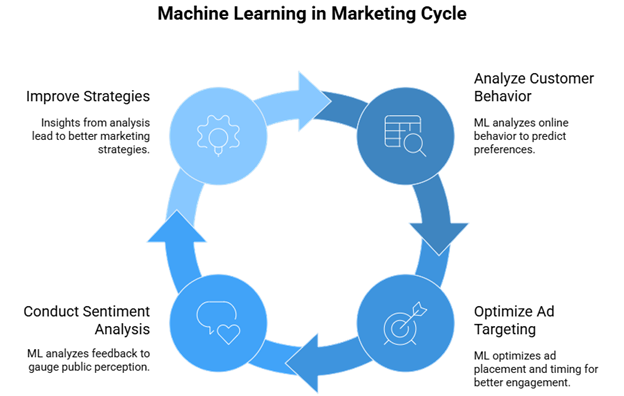
a) Customer Behavior Prediction
ML analyzes online behavior for customer preference predictions and purchase intention. These real-life examples of Machine Learning offer timely, relevant offers that better convert.
Predictive knowledge allows companies to carry out targeted campaigns and enhance customer satisfaction, which ultimately benefits brand loyalty.
b) Ad Targeting and Optimization
ML for ad placement, format, and timing optimization across platforms. These real-life examples of Machine Learning achieve greater click-through rates and lower cost per acquisition.
An analysis of timely data affords marketers a chance to rethink their campaigns and implement changes, should that be required, for the greatest impact.
c) Sentiment Analysis
It is the customer feedback, the reviews, and the social media comments that are analyzed by ML processes to establish a sentiment toward the brand. Real-world Machine Learning examples are hence buying companies the ability to judge public perception and consequently act on it.
These sentiment insights assist product improvements, resolve problems, or strategize further communications. These applications, therefore, represent important Machine Learning Use Cases in digital marketing today.
How Machine Learning Keeps Networks Smart and Connected
Telecom companies handle huge networks, heavy data traffic, and innumerable customer interactions day in and day out. Real life examples of Machine Learning show how the industry has been leveraging data intelligence for improving service quality, ultimately to avert outages, and for enhancing customer experiences. Hence, with ML, network management can be fully automated, with real-time optimization of network performance.
With ML, telecom operators can foresee network abnormalities, channel bandwidth optimally, and customize customer services. They help make telecom networks wiser, reliable, and scalable to meet the demands of the digital world.
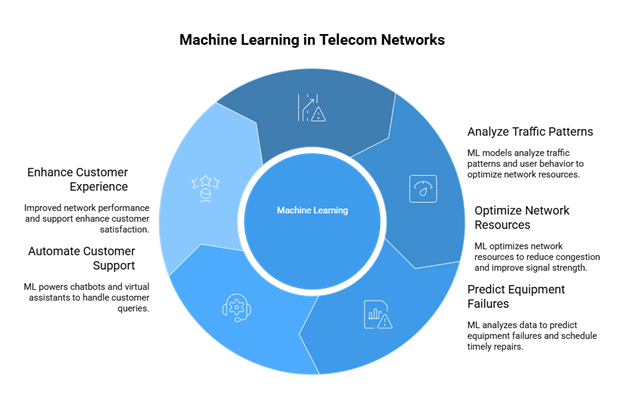
a) Network Optimization
ML models analyze traffic patterns and user behavior to optimize network resources. These real-life examples of Machine Learning will help telecom companies to reduce congestion and improve signal strength for better connectivity.
So far, it proactively caters to averting downtimes during peak usage, thereby minimizing instances of delays and dropped calls.
b) Predictive Maintenance
ML analyzes data coming from towers and infrastructure to predict equipment failures. Such Machine Learning applications enable critical repairs to be accomplished in time, minimizing downtime and optimizing operational expenditure while also ensuring uninterrupted service delivery and increased customer satisfaction.
c) Customer Support Automation
Machine Learning powers chatbots and virtual assistants to answer common customer queries. These real-life Machine Learning applications provide 24-hour support, swiftly resolve issues, and give human agents time to concentrate on difficult tasks. Intelligently supported systems prove worthwhile and are drivers shaping emerging trends in machine learning in telco innovation.
Read More: Future of Machine Learning in AI: Opportunities & Challenges
How Machine Learning Strengthens Digital Security
Cybersecurity systems are protected by Machine Learning in the scenario where there is some form of malware detection, or breach prevention, and rapid analysis of attack patterns contrasting conventional means and methods. Malicious activity interdiction is what is being learned from past incidents and adapted to from evolving threats-a solution of active response and discipline, defending users, data, and systems alike over various industries.
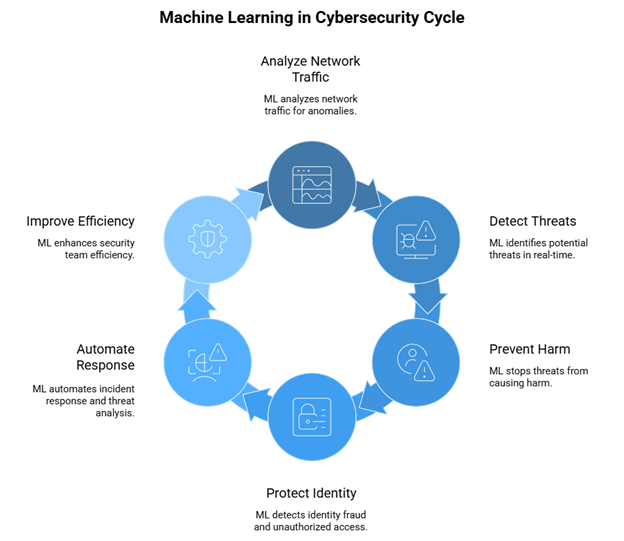
a) Threat Detection and Prevention
Machine learning in these examples and applications analyzes network traffic and user behavior anomalies. Such potential threats are immediately identified and stopped from any harm at their inception. Because these attacks are caught in real time, it gives the least amount of time and exposure to risk for the organizations.
b) Fraud and Identity Protection
ML can detect identity fraud by detecting unusual login patterns or payment behaviors. Some real-life instances of Machine Learning prevent unauthorized access and financial fraud. Automated detection mechanisms allow the issue to be counteracted much faster, thus providing a higher degree of user protection.
c) Incident Response Automation
ML assists with triaging alerts, threat analysis, and action suggestions. Real life examples of Machine Learning provide speedier responses and improve the operational efficiencies of security teams. Security systems that are ML-driven are important use cases of Machine Learning that allow companies to stay ahead in the race against cyber risks.
How Machine Learning Improves Public Services
Governments turn to technology to improve service delivery, maintain public safety, and for resource management. This includes some of the real-life examples of Machine Learning in the public sector for traffic optimization, fraud detection, and citizen engagement tools. ML thus helps agencies to make better decisions, cut down wastage, and service citizens better.
By analyzing public data, ML promotes proactive policymaking and real-time resolution of issues. Consequently, these tools help make governance efficient, transparent, and responsive.

a) Smart City Planning
ML models analyze traffic, energy consumption, and public movement to plan smarter cities. These real-life examples of Machine Learning help reduce congestion, manage utilities, and improve urban living. Data-driven planning leads to safer cities that are also more sustainable.
b) Tax and Benefits Fraud Detection
In real life, governments apply Machine Learning to detect fraudulent insurance claims or tax evasion. These examples of machining learning study the financial data and flag cases of inconsistencies automatically. Therefore, they increase compliance and curb losses for worthy uses of public funds.
c) Citizen Engagement
Machine learning powers chatbots and digital assistants for public inquiries and service access. These real-life examples of Machine Learning make services more accessible, faster, and user-friendly. Increased engagement builds public trust and satisfaction; goals industries work for using machine learning in the public sector.
Conclusion
Real-life examples of ML show how the working of the world is being impacted by the boost of efficiency, accuracy, and decision-making. With applications ranging from healthcare, finance, manufacturing, and government, ML is improving lives on a larger scale. By building up ML in their areas, businesses win at competing with ones having better insights and automation. These improvements are also transforming the customs in which businesses operate and the manner in which services are provided. The world belongs to people who will use ML responsibly and effectively. Across every Machine Learning sector, one thing has remained true- ML is no longer optional; it is mandatory for growth and success.
If you are looking for Azure Machine Learning Services, you can visit here.
Frequently Asked Questions
1. What are some real-life examples of Machine Learning in everyday use?
Some real-world Machine Learning examples include personalized recommendations on streaming platforms, fraud detection in banks, voice assistants such as Siri or Alexa, and real-time traffic updates in navigation apps. These tools use ML algorithms to analyze a vast amount of information and provide experienced-user smarter, faster responses.
2. Which industries are using machine learning the most?
Important industries for Machine Learning would be healthcare, finance, retail, manufacturing, transportation, and energy. Operational sectors use ML to automate processes, enhance decision-making, improve customer service, and reduce costs.
3. How does machine learning improve business operations?
Machine learning analyses large datasets for patterns or for outcomes and expects repetitive processes to be carried out. This leads to better forecasting, less chance for error, optimization of resource management, and reduction of other variables, all of which stand as key examples of Machine Learning in the real world.
4. What is predictive maintenance in machine learning?
Predictive machine learning maintenance uses sensor data together with past patterns for downloading failure prediction. This allows businesses to do maintenance proactively and face less downtime, hence saving costs, which basically is very valuable in manufacturing and logistics.
5. What are the current machine learning industry trends?
According to the trends, trending things in machine learning these days are: explainability in AI, increased use of ML at the edge (edge computing), increased privacy preserving ML techniques, and acceptance of ML by small and medium businesses by cloud services. These trends are increasing the dimensions and impact of ML in various industries.



